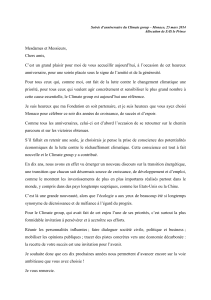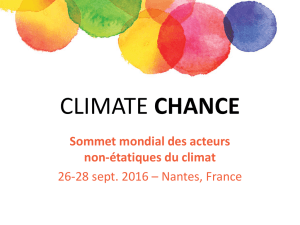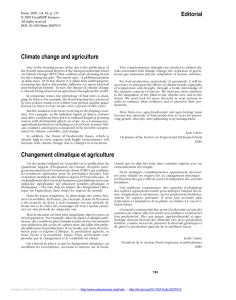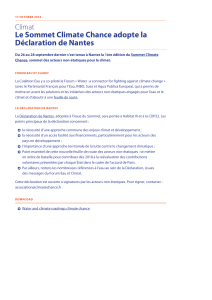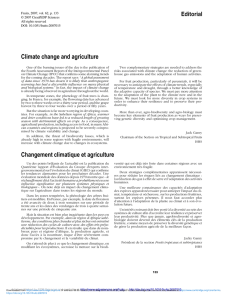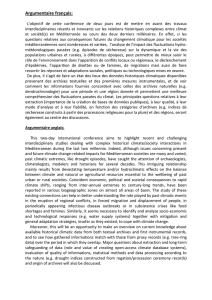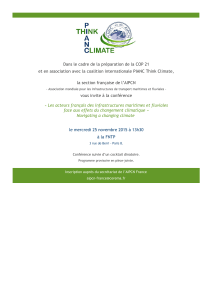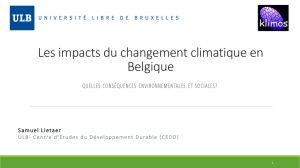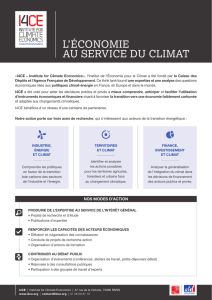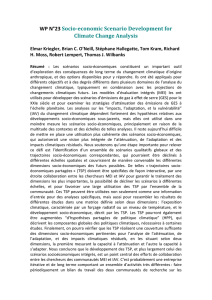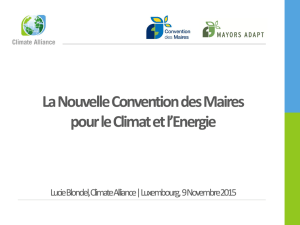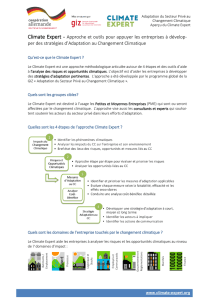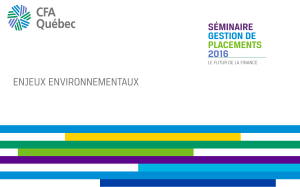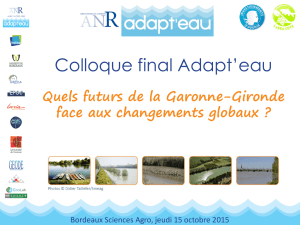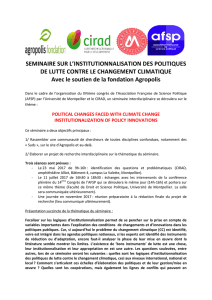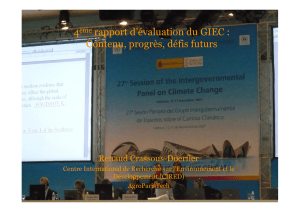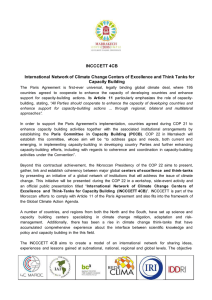Ouranos approach in integrated climate pp g change and adaptation
publicité
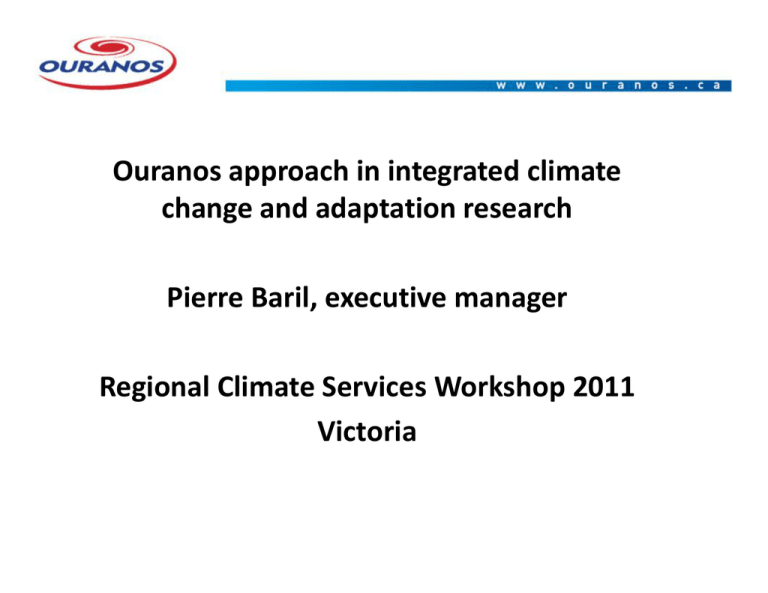
Ouranos approach pp in integrated g climate change and adaptation research Pierre Baril, executive manager Regional Climate Services Workshop 2011 Victoria Ouranos consortium structure to facilitate adaptation Deputy/Minister Members Scientific Council Board of Director Adjoint Deputy Minister or Director Chief Executing Officer Informatics REGIONAL CLIMATE Administration Communication IMPACTS AND ADAPTATION NORTHERN ENVIRONMENT CLIMATE SIMULATIONS CLIMATE SCENARIOS HYDRO CLIMATIC ANALYSES Internal capacity to produce relevant hydroclimate science Contributed manager or coordinnator HEALTH MARITIME ENVIRONMENT ENERGY PRODUCTION BUILT ENVIRONEMENT FORESTS RESOURCES NATURAL ENVIRONMENT AGRICULTURE WATER RESOURCES TOURISM/LEASURE Building on an extensive network of applied experts and involving users Contributed expert/scientist VARIOUS LEVELS OF ENGAGMENT FROM MEMBERS IN CHARGE OF MAINSTREAMING ADAPTATION Ensemble de projections régionales sur Amérique du Nord (domaine AMNO) à 45 km Multi-GCM; Multi-RCM; Multi-réalisations suivant scénario d’émission SRES A2 Mise à jour 23-11-2009 Which climate scenarios for which targeted needs? The "users" context likely plays a more important role than available science •Direct/indirect use of meteorological models outputs? (quantitative, qualitative, none) •Use of the historical information for planning? (climate, past impacts, experiences…) •Complexity of links between weather/climate vs impacts? (direct, indirect, diffuse) •Issues linked to which statistical parameter of climate? (means, threshold, extremes) •Biophysical vs socioeconomic focus? Type of adaptation process targeted? •Culture/Approaches of thematic experts and users? (Eg: problem, solution approach) •Nature and treatment of EVERY sources of sometimes competing uncertainties? •Resources historically dedicated to medium/long-term planning, adaptive capacity? •«Mainstreaming» potential at short, medium and long-term? •Others… Which climate scenarios for which targeted needs? Types of scenarios needs needs: (not including needs for efficient communication to broader audience) Expertise Value Value-added added Applied Support Data* R&D •Little or no need (analysis of vulnerable populations, adaptation options, broad policies to insert flexibilities…) ≈ -- -- •Interesting but optional (biophysical vulnerability mapping preventive approach mapping, approach, recycling existing results results…)) ↑ ≈ -- •Scanning GCM/RCM and synthesis charts (risk-scanning, what-if scenarios, issues with many uncertainties…) ↑ ↑ ≈ •Medium complexity (to anchor with I&A approaches used: link to ecosystems mapping, spatial analogues, … ↑↑ ↑↑ ≈ •Complex but applicable (with detailed analysis integrating into currently used tools : IDF, PMP, water management…) ↑↑ ↑↑ ↑ •Complex C l with ith R&D challenges h ll ( (connected t d R&D needed d d in both climatology and I&A: coastal erosion, forestry, …) ↑↑ ↑↑ ↑↑ *Data usually found on «scenario websites» are often not value-added w.r.t. the specific needs of a given user Quels scénarios climatiques pour rencontrer quels besoins? •Peu ou pas de besoins pour analyse de populations vulnérables, analyse d’options, capacité d’adaptation… Risques liés à la dégradation du pergélisol au Nord Besoins en habitation dans une vallée vulnérable Aires propices à la construction résidentielle ULaval. (mais zonage à raffiner au vu de nouvelles connaisances sur les tills) Source: Centre d’Études Nordiques (2005) Diverses synthèses de l’ensemble des scénarios possibles Changement de température et de précipitation pour le Sud du Québec [2040-2069] comparé à [1961-1990] Model=colour A1B Saison Hiver Printemps Été Automne B1 A2 Température Précipitation Température Précipitation Température Précipitation Température Précipitation Changement Horizon 2020 1.3 à 2.3 °C 3.7 à 11.1 % 1.0 à 1.7 °C 2.0 à 8.6 % 1.1 à 1.7 °C -1.5 15à4 4.4 4% 1.2 à 1.9 °C -2.7 à 3.6 % Changement Horizon 2050 2.5 à 3.8 °C 8.6 à 18.1 % 1.9 à 3.0 °C 4.4 à 13.1 % 1.9 à 3.0 °C -1.8 18à5 5.4 4% 2.0 à 3.1 °C -0.7 à 7.7 % Changement Horizon 2080 3.6 à 5.7 °C 14.5 à 27.6 % 2.7 à 4.3 °C 8.9 à 22.2 % 2.6 à 4.4 °C -4.9 49à6 6.0 0% 2.7 à 4.5 °C 0.4 à 12.8 % Source : Groupe Scénarios climatiques Ouranos Déplacement des isothermes Projet CCBio Complexité moyenne s’arrimant à des besoins spécifiques Exemple de cartographie: Comment les isothermes de déplacent-elles? Répartition observée du Cardinal pour 1961-1990 Changements de la répartition projetée pour la période 20412070 Source: Projet CCBio de D. Berteaux, UQAR (2011) Changements de la répartition projetée pour la période 20712100 Scénarios plus complexes: Applications poussées et… populaires Intensité maximale en climat estival futur (utilisant le MRCC sur le Sud Québec) Source: Mailhot et al al. Source: A. Mailhot et al., INRS-ÉTÉ (2007) Quels scénarios climatiques pour rencontrer quels besoins? Influence de la calibration de FORHYM sur les projections 2050 • Humidité dans le sol: Deltas entre les projections du contenu en eau pour l’horizon 2050 et la période de référence 1970. Les données utilisées comme entrées dans le modèle FORHYM proviennent du MRCC 4.1.1 ACU (CGCM3 run 4 SRES A2), domaine Québec. Source: D. Houle, Ouranos/MNRF (2011) To quantify information for decision makers Orientations and action plans Scientific reliability: High to very high Decision making at small scale: Cases studies Scientific reliability: Medium to high 2004 2008 2004-2008 Scientific S i tifi reliability: li bilit Low to medium 2001-2003 Issues determination: Projects Experiences And laboratoty Department & Universities Research Atmosphere-land-sea Universities Process-Observation Scientific reliability: minimum to low 2009-2013 1997-2000 Theory and fundamentals on climate science Beauchemin, 2002 Th k you ! Thank
